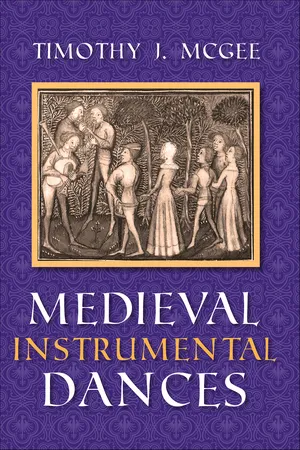![]()
Critical Notes
With the exception of Nos.1b and 30, the dances are all unica and are found in widely varied sources. The manuscripts are from the thirteenth, fourteenth, and early fifteenth centuries, and originate in England (3), France (10), Italy (3), and Czechoslovakia (2). They employ a variety of notations, including modal rhythm, French and Italian mensural notation, and keyboard tablature (a combination of notes and letters). The sources, their notations, and the editorial solutions are discussed below. The following abbreviations are used: n. = note; mx = maxima; 1 = longa; b = breve; sb = semibreve; m = minim; sm = semiminim. For complete citations of the facsimiles and transcriptions listed for individual dances, see pp. 175–77 below.
No.1a. Kalenda Maya | Vocal estampie |
Unique music source: Paris, Bibliothèque Nationale, fonds français 22543, fol. 62r.
Sources of text:
Paris, B. N. fonds fr. 22543, fol. 62r, 519.
Paris, B. N. fonds fr. 856, fol. 125 (unique source of verse 5).
Paris, B. N. fonds fr. 12474, fol. 106.
Barcelona, Bibl. de Catalunya 146, fol. 59.
The author of the text of “Kalenda Maya” is troubadour Raimbaut de Vaqueiras (ca. 1155–1205), but the story that he wrote the poem to a melody he heard performed by two jongleurs at the court of Montferrat is questionable, see above, p. 10.
MS 22543, the only source of the music, was copied in western Provence ca. 1300. It is one of two surviving books devoted entirely to the transmission of troubadour songs with their melodies; it contains 950 poems, 160 with melodies.1
The most common system in use for the rhythmic interpretation of twelfth- and thirteenth-century monophonic music follows the theory developed at the turn of the present century by Jean Beck and Pierre Aubry: The shapes of the neumes are ignored, and long and short values are assigned according to the stresses in the syllables of the poetry.
2 This theory has been seriously questioned recently as being arbitrary and unfounded in either the theories of the Middle Ages or the notation.
3 There are no known treatises that deal with rhythm in monophonic music, and thus I have chosen to follow the only other available guide—the principles established in theoretical writings for the notation of polyphonic music. Throughout the manuscript neumes are used in patterns that suggest that their shapes are intentionally chosen and therefore may well signify duration, as they do in polyphony. The scribe of “Kalenda Maya” has used the longa as the basic neume with occasional ligatures and plicas. My transcription interprets each neume mensurally, resulting in a composition that is almost totally isosyllabic. The caesura mark is interpreted to be a phrase mark but without specific value; its value is adjusted to the needs of the text stresses. That is, the caesura marks at the end of the note
for faia (bar 2) and
glaia (bar 4) are similar, but the text stress requires different rest lengths. They only deviation from strict isosyllabic transcription is in the assignment of a half note instead of a quarter note to the last syllable in a full phrase. The neume
has been interpreted as 1, mx (
) in line 5, n.4, 5.
The repeat of the refrain is editorial,4 and it is suggested that the last four lines of verse 1 be sung to this section following each stanza. Text edition from Joseph Linskill, The Poems of the Troubadour Raimbaut de Vaqueiras (The Hague: Mouton & Co., 1964), pp.185–87. Translation by Robert Ta...



